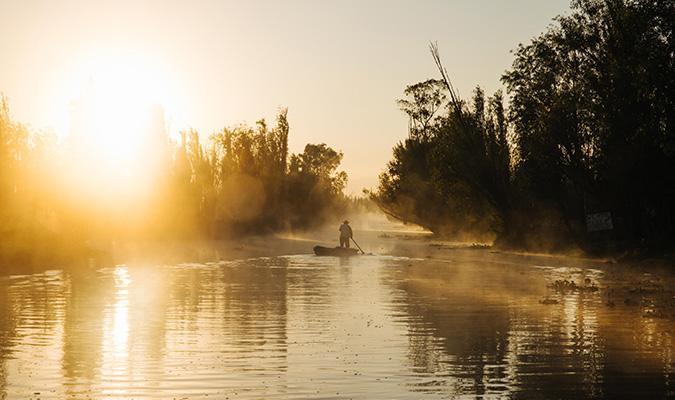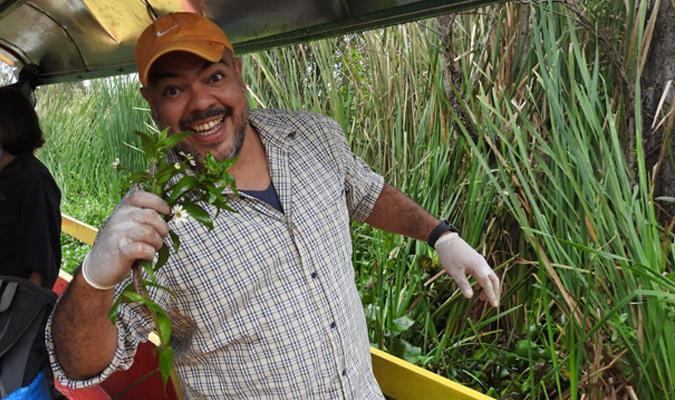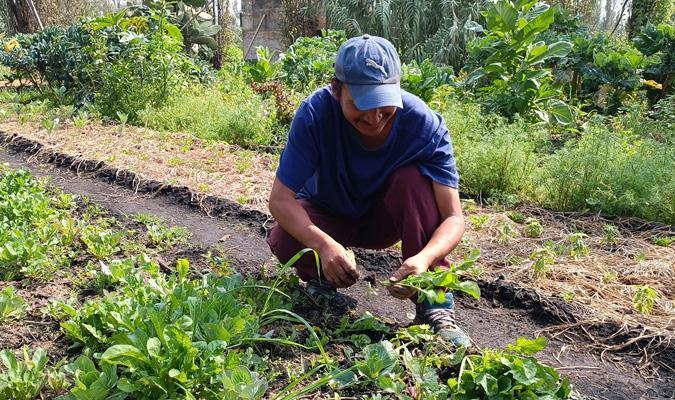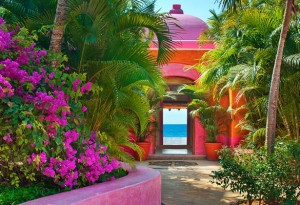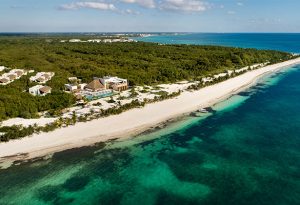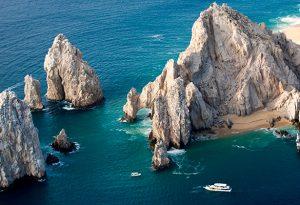Our Changemakers series tells the stories of the people proactively responding to challenges faced by Mexico`s natural world and communities. Our aim with these articles is to spread the word, share knowledge, and inspire action.
Today, we`re journeying to Xochimilco`s waterways in the south of Mexico City to meet Martin Sanchez, a biologist, lifelong advocator for sustainability, and chairman of the board for REEDUCA, a Nonprofit Civil Association formed in the capital.
In this article, we’ll be zooming in on Martin`s work with Chinampas en Movimiento project, part of a wider movement to restore and protect the chinampa farming system, which we support through Journey Mexico`s Positive Impact Fund. This brilliant initiative strives to reactivate the pre-Hispanic “chinampa” ecosystem through an agroecological, sustainable, and collectively responsible model. Through restoring, maintaining, and working the chinampas to cultivate fresh produce, the project provides jobs, raises awareness about food security, preserves ancient agroecological techniques and provides refuge for local wildlife, including the endangered axolotl salamander.
Journey Mexico`s content writer, Sally (SW), had the pleasure of sitting down for a chat with Martin and tapping into his knowledge. But before we dive into the highlights of our Q+A, let’s step back in time for some context:
What is REEDUCA ?
The organization began as a grassroots network initiated by parents seeking to enrich the environmental education programs at their children`s schools, before formalizing in 2021 to focus on conservation and the sustainable use of Mexican biodiversity. Now, REEDUCA`s multidisciplinary team of biologists and educators runs and collaborates on several campaigns in Mexico City and the Pacific Coast:
- Chinampas en Movimento: reactivating pre-Hispanic, agroecological crop cultivation techniques in Xochimilco`s chinampas (man-made plots of fertile land).
- Jardines Polinizadores: promoting the creation of pollinator gardens in collaboration with CONABIO (National Commission for the Knowledge and Use of Biodiversity) to encourage the health of local ecosystems.
- Supporting and/or facilitating bird and sea turtle conservation projects.
- Organizing events, workshops and training related to the conservation of natural resources, biodiversity, and ecosystems.
Did you know Mexico City rests in the remains of an ancient lake?
The Aztec Empire`s capital, Tenochtitlan, was built on an island in Lake Texcoco, the largest of five interconnected lakes in the Valley of Mexico and home to the famous scene of an eagle perched on a cactus, eating a snake. As instructed by Huitzilopochtli, the Aztec God of sun and war, this was the place to build their spectacular city, which they did, and connected it via waterways. The Aztecs innovated man-made squares of fertile land fixed to the shallow canal beds called `chinampas`, complete with complex drainage systems to avoid flooding and networks of canals for canoes to pass through. The chinampas were used for sustainable crop cultivation, a feat of engineering and agriculture that also supported a great diversity of plant and animal life.
Fast forward five centuries to a cityscape that sprawls across the empty lake basin (eventually drained by the Spanish) with some wetlands to the east, and the last remaining waterways to the south that once connected the lower lakes to Tenochtitlan. While axolotls once thrived in the huge lake system, today, they are critically endangered due to habitat reduction, pollution, and the introduction of imported fish species. Our Changemakers chapter takes place here, in present-day Xochimilco, where we`ll hear Martin`s story about reviving Mexico City`s last remaining chinampas.
Martin’s Background in Sustainability
SW: As a biologist, when did you feel the call to start working within sustainable development?
MS: Since forever! I feel very fortunate because I had many opportunities as a young person to explore Mexico and understand the need to care for nature. A turning point in my life was when I was 13 years old, and I went to Chacagua´s lagoons on the Oaxacan coast. There is an area where the crystal-clear sea water merges with the coffee-colored water of the lagoon. Seeing that contrast, the flocks of parrots, and hundreds of birds, observing the crocodiles, I was so amazed. I remember my mom telling me, ‘son, pay close attention to this and enjoy it because it won’t be here forever,’ and I asked, ‘why?’. She said, ‘people have needs, and at some point, this will be destroyed,’ and I thought, ‘NO!’. From that point, I felt responsible for working towards conserving places like Chacagua. It gave my life meaning.
SW: What was your path to becoming chairman of the board for REEDUCA?
MS: I started studying biology at the UAM (Autonomous Metropolitan University), and there, I took part in a project on axolotls when I was 19. Additionally, during my high school summers, I participated in conservation camps where we did community work in protected areas and studied environmental education. In 2021, I volunteered for a civil association, Cuerpos de Conservacion Mexicanos, where we also conducted conservation programs with young people in the south of Mexico City. Later, I worked with the National Commission of Natural Protected Areas (CONANP) where I was responsible for a conservation project specifically in the Chacagua lagoons, so it came full circle. I oversaw conserving various endangered species, and I learned how to make policy decisions for their conservation. Afterward, I wanted to start my own civil association, and that’s when I joined REEDUCA, focusing with my collaborators on biodiversity conservation.
“Ecotourism plays an important role in raising awareness
and realizing the need to care for places;
we don’t protect what we don’t know.”
How does the Chinampa project work?
SW: How did REEDUCA start working with the chinampas?
MS: The chinampa where we currently work was rescued 13 years ago by another civil association called ‘Redes.’ It went through a crisis because it was a non-productive, demonstrative chinampa, so it focused on more academic and donation-based activities, such as seed and seedling exchanges with neighbors, consultations, providing training on production issues, and evaluating the conditions of the chinampa.
REEDUCA took over the chinampa during the pandemic, when Redes stopped receiving donations, making it unsustainable. We took the reins and began working within the framework of a productive chinampa that sustains itself through the sale of its agricultural products. Families in the city outside Xochimilco pay a monthly membership to receive regular hampers with produce from the chinampa. We call these families ‘co-farmers,’ and they also have access to go and help at the chinampa. Currently, we have 17 families receiving baskets, but ideally, we need more to reach a good number, around 25 families. We´re looking for families in Mexico City who want to receive baskets and support the project! Everything received directly by REEDUCA from the sale of vegetables goes towards fair salaries for our farmers and the maintenance of the chinampa itself.
SW: How has the local Xochimilco community received the chinampas project?
MS: People have received it very well; we´re in contact with the neighbors, many of whom cultivate agricultural produce or offer services. The economic spillover from the income generated by the chinampa goes directly into the community, so it`s well-regarded. We have a good relationship with the local community and follow the unwritten rules – which allows us to continue operating – such as treating people fairly, speaking with accessible language, approaching them directly to communicate, and making person-to-person agreements to be able to maintain both the chinampa and provide tours.
“Sustainability also involves being economically viable;
the project has to sustain itself.”
Protecting the Endangered Axolotl Salamander
SW: Can you tell us about the chinampas project´s work with axolotls?
MS: We`re currently in a certification process conducted by the National Autonomous University of Mexico (UNAM) and are now recognized as a ‘Chinampa Refuge´. This means that the water in our ´apantles´ (man-made irrigation canals) is high quality and suitable for receiving axolotls. We have a simple filtration system where water passes through channels with plants to retain fish that pose a threat to axolotls, such as carp and tilapia. The same plants also retain bacteria, microorganisms, and even invertebrates that can negatively affect water quality. Additionally, we have filters, nets, and rock mounds that further filter what passes through. So, in the two apantles we have, the water quality is much better than in the main canals. It’s a straightforward filter that has had a significant impact. We conduct water assessments that confirm the water quality is suitable for the axolotls as well as for irrigating the vegetables people will consume.
We´re planning to restore more apantles to accommodate axolotls from a project by the Biology Institute at UNAM and their ecological restoration laboratory. We are in the final stage of improving the apantles, where we`ll have a designated area specifically for the axolotls to live and reproduce.
“We currently have two microchipped axolotls
that Journey Mexico´s travelers can meet.”
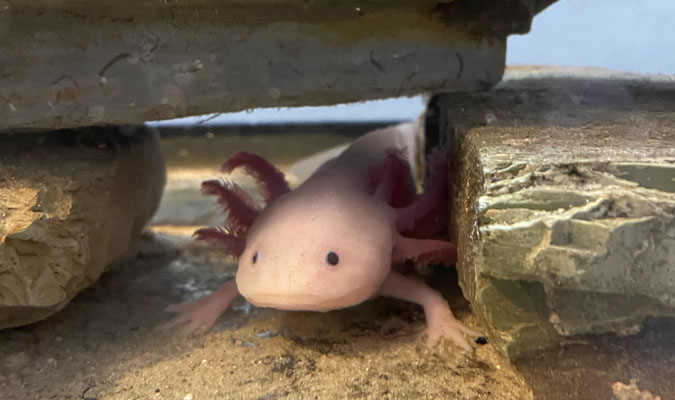
A Nature Haven in Mexico City
SW: We love showing our travelers that an area of such natural beauty exists in the bustling metropolis. How do your visitors react to Xochimilco?
MS: It’s a truly surprising experience, I can tell you that it astonishes 100% of the people who live it. I have not seen a single person who goes to Xochimilco to observe nature, experience the chinampas, and navigate in a trajinera, who is not left amazed. Many of them are so impressed that they come back to have the same experience.
I´m very passionate about birdwatching. In the past, I was hired to collect data on birds in Mexico City´s wetlands. I realized what a great treasure birdwatching is here and created my own bird guide that I give to Journey´s clients. In the protected area of Xochimilco, there are currently 187 registered bird species. On outings, we usually see around 25 species, and once, we spotted around 70!
“I have not seen a single person who goes to Xochimilco
to observe nature, experience the chinampas,
and navigate in a trajinera,
who is not left amazed.”
Visting Xochimilco’s Chinampa with Martin/Journey Mexico
SW: We´re so happy to offer our clients such a meaningful experience with your team in Xochimilco. What do you think makes it extra special?
MS: It’s incredible that Xochimilco is in the middle of the city, it`s such a beautiful place. It’s a truly unique site; you can go anywhere in Mexico, and there’s not even a slightly similar place.
It’s like a journey through time because it’s the way the Xochimilcas used to live. The indigenous roots are deeply embedded in the traditions—the way of moving around, the houses situated in the middle of the canals in certain areas, and the conservation of the area.
It’s a comprehensive 360-degree experience because we work within the local economy. The rowers of the trajineras (traditional, colorful, gondola-like boats) that take you to the chinampa are our collaborators; we know their names, know who they are, and are familiar with their life stories. We don’t use motorized boats; we do it in the traditional way by rowing and it creates a welcoming, cozy atmosphere. We have a special lunch menu for Journey Mexico`s guests where the food selection has meaning. Local cooks share their traditional daily food with pride and love, it`s intimate experience where visitors can get as hands-on as they like, grinding corn on the `metate` and making salsa in a `molcajete`.
By participating, you are genuinely contributing to the conservation of local biodiversity and ecosystems by supporting the chinampa that’s at the heart of the experience. You get to see how a system operates 100% sustainably and the cherry on top is getting to meet the axolotls, which we only do with Journey Mexico. Thanks to the chinampa project, we are truly taking care of their habitat.
“The other guides and I have known the chinampa system
for a long time,
so in biological, social, and historical terms,
it allows us to give an insider perspective.”
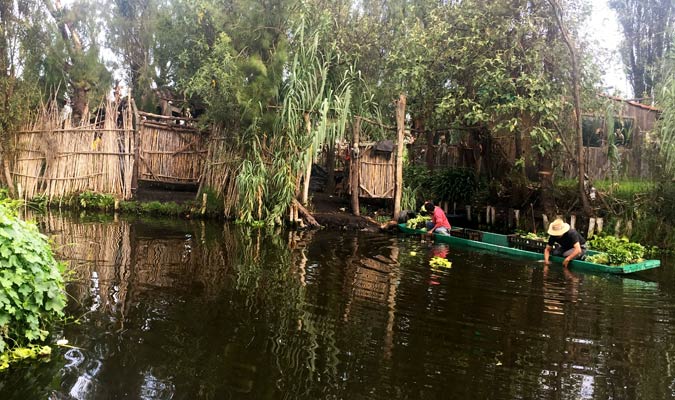
THE ROLE OF ECOTOURISM
SW: How important do you think ecotourism is to this and other projects?
MS: I believe any form of tourism that allows people to respectfully get to know and recognize places like Xochimilco is meaningful. Ecotourism plays an important role in raising awareness and realizing the need to care for places; we don’t protect what we don’t know. If you`ve experienced it in some way you will do something, be it a photo on your Instagram, to say this place is important.
“Our goal is to have a transgenerational impact
and leave a truly sustainable legacy for those who follow.”
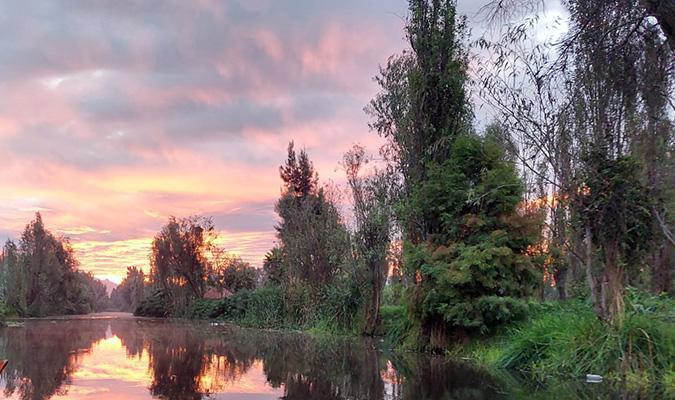
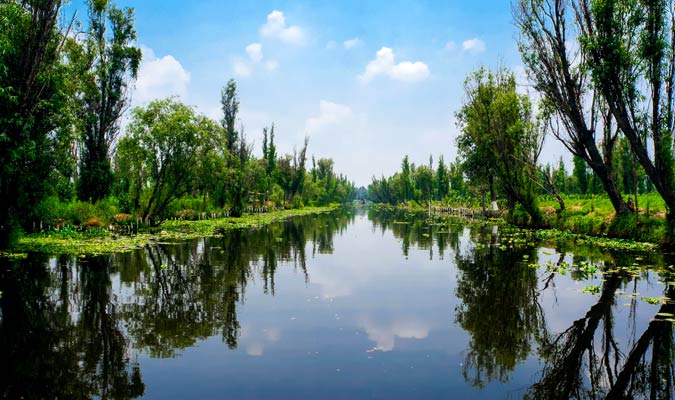
FUTURE ACTION
SW: What´s next for REEDUCA and Chinampas en Movimiento?
MS: In the short term, our goal is to restore the apantles and be able to welcome axolotls within a matter of months. Cleaning the apantles is a very specific task that requires specialized equipment from a provider and has an elevated cost, so there are a few elements at play.
At some point, we`d like to acquire our chinampa (we`re currently renting) so that it stays with the farmers and the same practices continue, ensuring that it is sustained in the short and long term, and future generations can enjoy what we have, or something even better.
We constantly have a flow of local young people who are volunteering or visiting the chinampa to have a different experience. I’m also a teacher at a high school where we have a social service program, and the students spend their time helping with chinampa tasks. This way, they become aware there is a place that is important; tomorrow, they`re the ones who’ll make the decisions. Our goal is to have a transgenerational impact and leave a truly sustainable legacy for those who follow.
SW: What parting message do you have for our readers?
MS: Give yourself the opportunity to visit! This is a genuine experience where you get close to and reconnect with nature. Your visit will have a direct impact not only through supporting Xochimilco`s conservation but also by conveying the message that you`re in a significant place.
Ready to travel back in time and visit Xochimilco’s chinampas?
A regenerative travel experience created exclusively for Journey Mexico, you can find more details about our signature chinampas tour here. Our Mexico-expert travel planners are happy to include this in any Mexico City itinerary you wish to plan – get in touch to start planning your very own personalized itinerary. Custom made trips to Mexico City start at $1,000 USD per day for two travelers.
The above excerpts were taken from an interview conducted via video call and translated from Spanish. Some editions have been made for brevity and clarity.
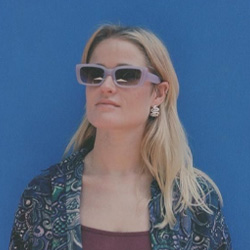 |
Author: Sally Wells
The British-born writer first fell for Mexico’s magic while studying Spanish in Guadalajara. A decade later, she’s taken her time getting to know the country’s multifaceted personality, and now calls Puerto Vallarta home. Sally has always had a soft spot for the written word and finds inspiration in life’s subtleties as much as the big moments. She loves stepping into someone’s world, listening to their experiences, and making connections. A firm advocate for candid communication, Sally believes storytelling has the ability to empower, enlighten, and spark empathy. |

